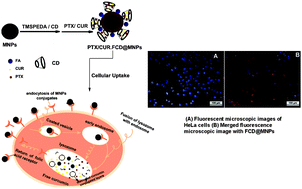Targeted coadministration of sparingly soluble paclitaxel and curcumin into cancer cells by surface engineered magnetic nanoparticles
Abstract
This study presents a feasible method for the fabrication of multifunctional magnetic

* Corresponding authors
a
Laboratory for Polymer Analysis, Sree Chitra Tirunal Institute for Medical Sciences & Technology, Poojapura, Trivandrum, India
E-mail:
sreeni@sctimst.ac.in
Fax: +0914712341814
Tel: +0914712520248
b Division of Biosurface Technology, Biomedical Technology Wing, Sree Chitra Tirunal Institute for Medical Sciences & Technology, Poojapura, Trivandrum, India
This study presents a feasible method for the fabrication of multifunctional magnetic

 Please wait while we load your content...
Something went wrong. Try again?
Please wait while we load your content...
Something went wrong. Try again?
S. Manju, C. P. Sharma and K. Sreenivasan, J. Mater. Chem., 2011, 21, 15708 DOI: 10.1039/C1JM12528A
To request permission to reproduce material from this article, please go to the Copyright Clearance Center request page.
If you are an author contributing to an RSC publication, you do not need to request permission provided correct acknowledgement is given.
If you are the author of this article, you do not need to request permission to reproduce figures and diagrams provided correct acknowledgement is given. If you want to reproduce the whole article in a third-party publication (excluding your thesis/dissertation for which permission is not required) please go to the Copyright Clearance Center request page.
Read more about how to correctly acknowledge RSC content.
 Fetching data from CrossRef.
Fetching data from CrossRef.
This may take some time to load.
Loading related content
